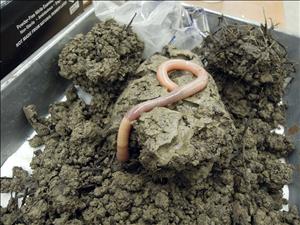On December 2, 1896, the "giant Palouse earthworm" as it will come to be called, is first reported. Rennie Wilbur Doane of the Department of Botany and Zoology at the Washington Agricultural College and School of Science in Pullman writes a short letter to earthworm expert Frank Smith. Doane says that he has sent “a few specimens from the vicinity ... [and that they] are about average size, some are very much larger.” Several months later, Smith, Professor of Systematic Zoology and Curator of the Museum of Natural History, University of Illinois, writes a description of the worms, describing them as a new species, Megascolides americanus. Known in modern times as the giant Palouse earthworm, Doane’s earthworms have become legendary -- rumored to spit, smell like lilies, and grow to three feet long -- but also rare, with just a handful of sightings over the past century.
Giant Wrigglers
Doane, an entomologist, wrote Smith again on January 16. He was glad of Smith’s interests and planned on collecting additional specimens in the spring breeding season. (There is no record of his doing so.) Doane added that “this one species is very abundant ... when roads have been cut through hills, I have seen their burrows as much as fifteen or twenty feet below the surface. I know very little of its habits.”
Smith’s formal description of the worms appeared in the March 1897 issue of The American Naturalist. He assigned them to the genus Megascolides, most of which had been found in Australia. (This genus includes several immense worms including Megascolides australis, the giant Gippsland earthworms, which have an average length of 29 inches and maximum of 120 inches.) He also noted that other worms in the same genus had been found in California but had nothing to add about their habits and habitats. The average length of the four specimens was 7 inches.
Little was written about the worms until Smith published a more detailed account in 1937. Despite the 40 years separating publications, he had only seen a handful of additional specimens, those collected on March 21, 1931, by Dr. Arthur Svihla in Pullman. These averaged an inch or so shorter than the previously collected specimens. Again, Smith wrote nothing about their ecology. He did, however, add four new species to the genus, two of which were from Oregon. (One of these, Megascolides macelfreshi, was later named the Oregon giant earthworm; it is reported to grow to more than four feet long.)
Mythical and Missing
And then like the town of Brigadoon, the giant palouse earthworm disappeared from public view. No one published any scientific papers and just one person reported capturing the elusive wrigglers, in 1978. Finally in 1990, William Fender and his mother, legendary worm expert Dorothy McKey-Fender, published a more detailed report. They renamed the animals, Driloleirus americanus. The new generic epithet means “lily-like worm,” a reference to the spittle of the closely related Oregon giant earthworm. Her husband was supposedly the first to discover the aroma when he squeezed one worm and it spewed a gooey, lily-smelling expectoration.
Fender and Mckey-Fender finally provided a bit of natural history. The big worms are found around Pullman and Moscow, Idaho, and near Ellensburg, but not in the arid lowlands between these locales. The Oregon giant makes permanent burrows in fine-textured deep soils and feeds on moss, bits of wood, and grass seeds and stems exclusively at or near the surface. It is assumed that the closely related Palouse species does the same but no one has seen them feeding.
Curiously, an additional fact crept into the popular lore of the giant Palouse earthworm: they could grow to mammoth sizes, up to a yard long. Most earthworm scientists believe the story developed because some child supposedly swung one of the earthworms around his head and it stretched to three feet. This information has never appeared in a scientific report. Despite the lack of any evidence the tale spread, leading to the worm’s portrayal in the popular press as “Moby Worm” and the “spineless subterranean Bigfoot.”
Preserving the Worm's Prairie
Now known by the public, the worms became a Holy Grail for worm experts but the subterranean animals remained elusive. In 2005 University of Idaho graduate student Yaniria Sanchez-de Leon found the first specimen in nearly 20 years. She was seeking earthworms on Washington State University’s Smoot Hill near Albion, when on the final plunge of her shovel, she pulled up a worm, or at least half of one. Three years later, Karl Umiker, a University of Idaho research support scientist and undergraduate student Eric Robertson found another one, again chopped in two by their shovel.
Scientists obtained their Holy Grail on March 27, 2010, when Umiker and Shan Xu, a graduate student from Chengdu, China, captured two live giant Palouse earthworms, a juvenile and an adult, and three egg cocoons. They were using a tool called an electroshocker, which jolted the soil with a weak current. The adult was 10 inches long and pink. The worms were found on a small patch of native prairie near Moscow, Idaho.
In addition to facilitating further studies of the earthworm, the discovery has revived efforts to protect their animals’ dwindling habitat. Conservationists petitioned the federal government to list the earthworms as an endangered species. Doing so would have meant preserving the remaining areas of prairie that provided suitable habitat. That petition was rejected and a second petition was filed in 2009.
Scientists are continuing to search for additional giant Palouse earthworms, as well as study the ones that remain. The adult had to be killed, for identification purposes, but the juvenile and a several new borns are doing well. Perhaps some day researchers will get them to spit.

